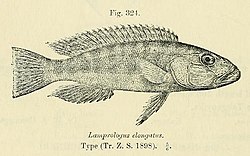| Lepidiolamprologus | |
|---|---|
 | |
| Lepidiolamprologus elongatus | |
 | |
| (L. nkambae) | |
| Scientific classification | |
| Kingdom: | Animalia |
| Phylum: | Chordata |
| Class: | Actinopterygii |
| Order: | Cichliformes |
| Family: | Cichlidae |
| Tribe: | Lamprologini |
| Genus: | Lepidiolamprologus Pellegrin, 1903 |
| Type species | |
| Lamprologus elongatus Boulenger, 1898 | |
| Synonyms | |
Lepidolamprologus( lapsus ) | |
Lepidiolamprologus is a small genus of cichlids endemic to Lake Tanganyika in eastern Africa. It is closely related to Altolamprologus. and there is the possibility that a revision of the genus could see more species added. [1]
The placement of L. cunningtoni has been questioned, as it seems to be a close relative of N. modestus and the Fourspine Cichlid (N. tetracanthus), though with hybridization running rampant in the Lamprologini, one cannot entirely be sure of its relationships at present. However it differs enough from the other species in Lepidiolamprologus to conclude that it may not belong in this genus. [1] [2]